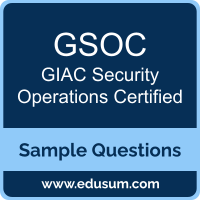01. During the sharing phase of analytics, what is an effective practice for fostering understanding and engagement among stakeholders?
(Choose Three)
a) Utilizing interactive visualizations
b) Providing detailed technical documentation to all stakeholders regardless of their background
c) Tailoring the presentation to the audience's level of expertise
d) Offering actionable insights based on the data
e) Limiting access to data to prevent information overload
02. Why is it crucial to secure SSH communications, particularly for administrative access?
a) Because securing SSH is mandated by all data protection regulations
b) Because SSH is commonly used over untrusted networks
c) Because unsecured SSH can provide an attacker with elevated privileges and access to sensitive areas of the network
d) Because SSH does not support strong encryption
03. How do Threat Intelligence Platforms (TIPs) enhance the effectiveness of a SOC?
a) By replacing the need for human analysts
b) By providing actionable intelligence on emerging threats
c) By functioning as the primary data storage solution
d) By automating all incident response actions
04. Which two sources of information are critical for analyzing Windows system events?
(Choose Two)
a) The Application log in Event Viewer
b) The Security log in Event Viewer
c) The Recycle Bin's metadata
d) The Windows Update log
05. In the context of analytics enrichment, which of the following is considered a best practice?
a) Ignoring data source reliability
b) Incorporating external data sources for enhanced insights
c) Using only internal data to avoid external biases
d) Enriching data at random intervals
06. When securing endpoints, which two measures are effective in preventing unauthorized access?
(Choose Two)
a) Enabling auto-run features for external media
b) Implementing full disk encryption
c) Applying strong, unique passwords for each endpoint
d) Allowing users to install their applications to ensure they have tools they prefer
07. Which factor is crucial when prioritizing incident response?
a) The phase of the moon
b) The personal interest of the responding analyst
c) The geographic location of the attacker
d) The incident’s potential impact on the organization
08. For effective network traffic analysis, what should be considered when monitoring encrypted traffic?
(Choose Three)
a) The increase in CPU usage due to encryption and decryption processes
b) The possibility of encrypted malware communication
c) The certificate authority (CA) issuing the certificates
d) Establishing baselines for normal encrypted traffic patterns
e) Ignoring encrypted traffic as it is always secure
09. What advantage does integrating a Threat Intelligence Platform with a SIEM offer to a SOC?
a) It provides a direct marketing channel to potential clients.
b) It transforms the SIEM into an autonomous AI entity.
c) It enables correlation of external threat data with internal event data for enhanced analysis.
d) It allows the SOC to broadcast threat alerts on television.
10. What is a crucial factor in a SOC's success in improving an organization's security posture?
a) Conducting regular and comprehensive training for SOC staff
b) Isolating the SOC team from the rest of the IT department to avoid biases
c) Limiting the SOC's access to essential systems only
d) Focusing exclusively on external threat intelligence
 The purpose of this Sample Question Set is to provide you with information about the GIAC Security Operations Certified (GSOC) exam. These sample questions will make you very familiar with both the type and the difficulty level of the questions on the GSOC certification test. To get familiar with real exam environment, we suggest you try our Sample GIAC GSOC Certification Practice Exam. This sample practice exam gives you the feeling of reality and is a clue to the questions asked in the actual GIAC Security Operations Certified (GSOC) certification exam.
The purpose of this Sample Question Set is to provide you with information about the GIAC Security Operations Certified (GSOC) exam. These sample questions will make you very familiar with both the type and the difficulty level of the questions on the GSOC certification test. To get familiar with real exam environment, we suggest you try our Sample GIAC GSOC Certification Practice Exam. This sample practice exam gives you the feeling of reality and is a clue to the questions asked in the actual GIAC Security Operations Certified (GSOC) certification exam.